#Native Species
Text



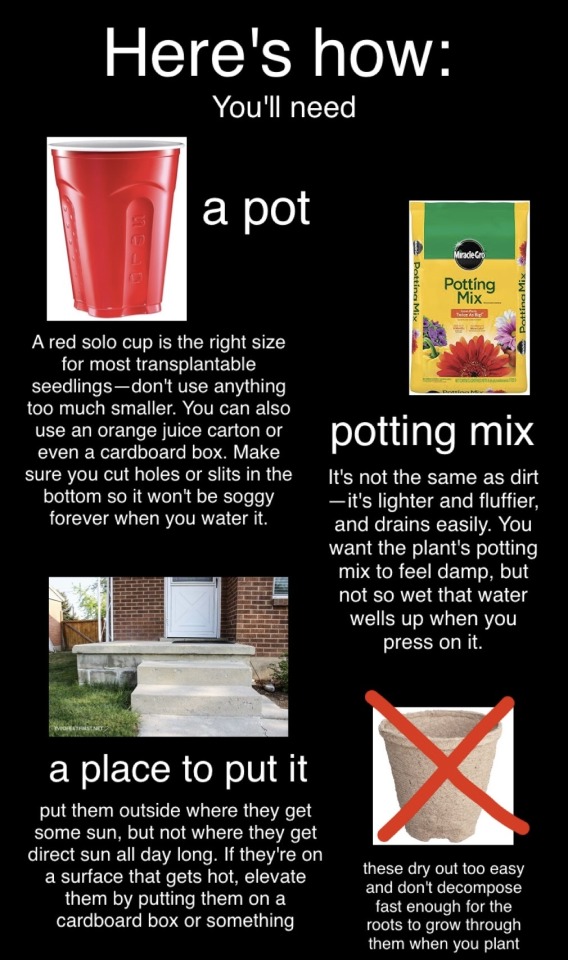



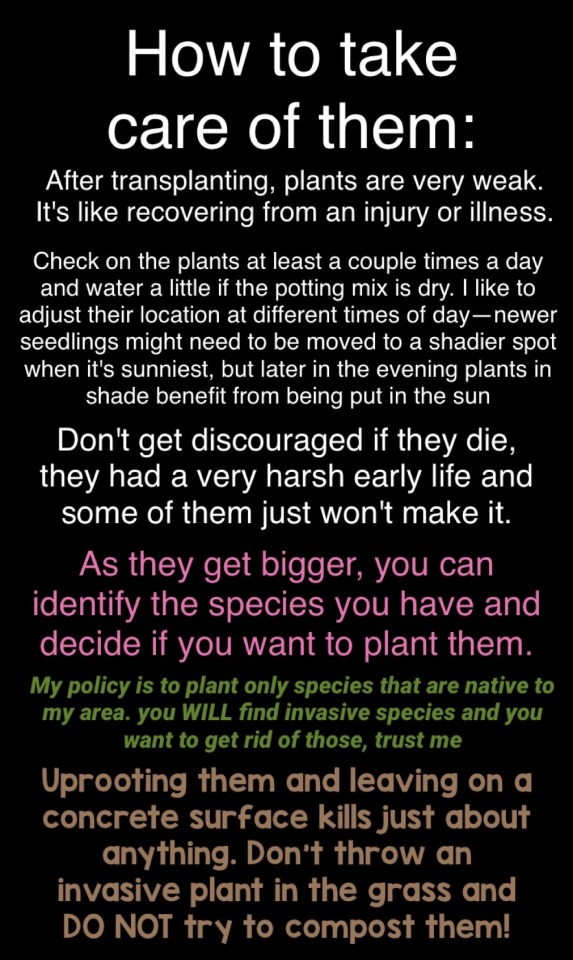

as promised, the transplanting tutorial
most sources make transplanting sound incredibly difficult, but transplanting young seedlings from areas with sparse dirt, like a driveway or roadside, is actually incredibly easy and can get you some great stuff. Once I worked out the method, i've had a very high survival rate
it took me like a month of trial and error to figure this out so you don't have to.
Feel free to repost, no need for credit
28K notes
·
View notes
Text


I went for a hike with one of my favorite humans today and found this little darling sunning themselves on a popular trail. I decided to move them off the path as there were a LOT of bikes whizzing by, and they were so polite! No hissing, no musking, no bites!
@snake-spotted I thought you'd appreciate my new friend too!
174 notes
·
View notes
Text
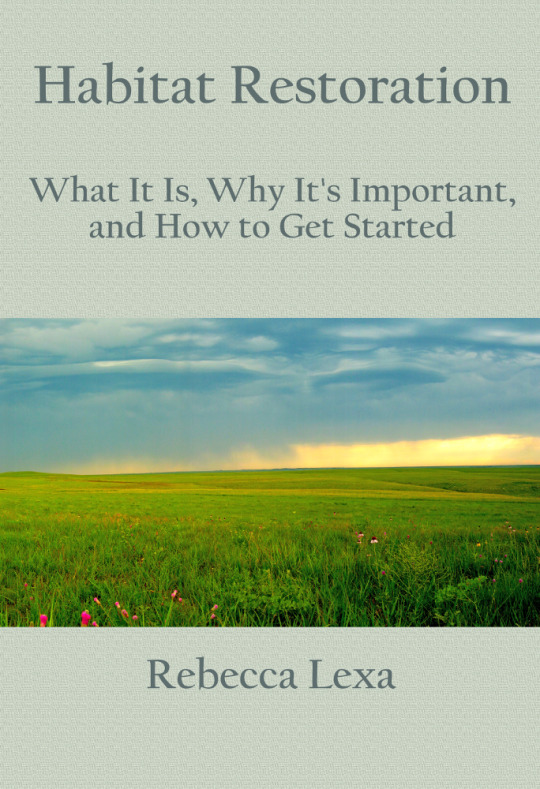
Happy Spring! I've just released my newest quarterly chapbook, Habitat Restoration: What It Is, Why It’s Important, and How to Get Started.
Habitat loss is the single biggest cause of species becoming endangered or extinct. Thankfully, we can help our local animals, plants, and other beings by restoring their habitat–even in our own backyards, gardens, and porches! Get the basics of what you need to know about:
What habitat restoration is
Why it’s important
How to get started
Troubleshooting your restoration project
Further resources
Whether you’re an experienced gardener wanting to grow native plants, or a nature-lover trying to make your corner of the world a little better place, this book will get you started on your own small-scale habitat restoration project.
You can get the ebook for free right now by signing up for my monthly email newsletter at https://rebeccalexa.com/news-updates/. Or if you want to purchase a paperback, it's available for just $6 plus shipping at https://rebeccalexa.com/habitat-restoration/
(Reblogs okay and encouraged--thank you!)
#habitat restoration#restoration ecology#ecology#nature#outdoors#gardening#native plants#invasive species#plants#garden#native species#endangered species#conservation#environment#environmentalism#self publishing#self published#free ebooks
1K notes
·
View notes
Text



I was so, so lucky to meet a very special trio of snakes for a class I'm taking on methods in field ecology. One of my two professors is a specialist in garter snakes and was kind enough to bring three different species in for us to compare in person and observe up close. The first was the gorgeous common garter snake, Thamnophis sirtalis, pictures above. She was so calm and well-mannered!
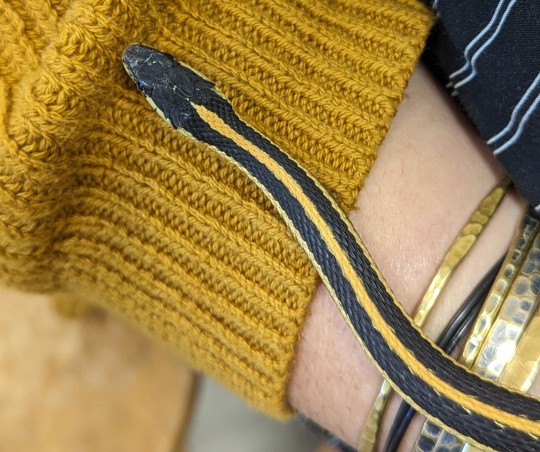


Next was this tiny (by comparison) T. elegans dude, a western garter snake, who was wary of the camera but very patient about being passed around by a group of excited college students. He matched my classmate's sweater perfectly!

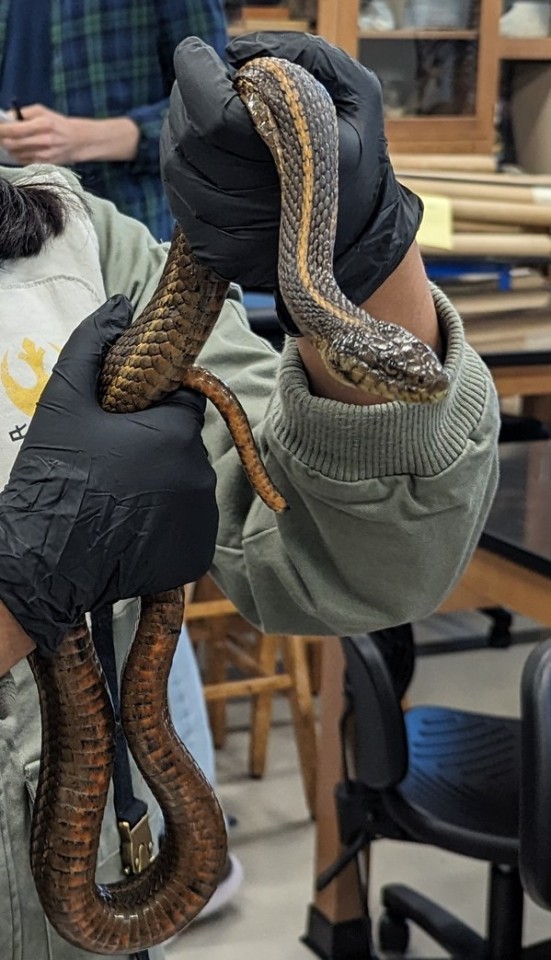

Finally, an endangered and incredibly precious T. gigas, the giant garter snake. She's about half of her maximum adult size, so a giant indeed! She musked and peed a bit but for the most part this gojira-faced beauty was pretty chill. We got to observe a full work-up for her including documenting records and microchipping.
She's one of the last of her species. Despite Herculean efforts by her protectors and conservation experts (mostly just one man and his dedicated team), this is a very difficult species to observe in the wild and their habitats are disappearing faster than their need for prioritization of protection in a given area can be assessed. These snakes rely on riparian habitat near rivers, which is also unfortunately a favorite for human development. At this time we don't know how exactly many giant garter snakes are left or whether their current populations are stable.
Today we got to visit their marshland habitat and watch these three go back to the place where they were caught. It was a huge honor and something I'll carry with me forever.
#snake#snakes#reptile#reptiles#reptiblr#garter snakes#garter snake#native species#we put that thing back where it came from or so help me#so help me!#science#ecology#endangered species#giant garter snake#western garter snake#common garter snake#when i got home i ate a salad so big that it made me sleepy
466 notes
·
View notes
Text
It would be nice if humanity could reach a point where landscaping like this is not okay. I walk past this area frequently, and they regularly nuke everything with roundup and remove all the detritus. Think of all the arthropods and other wildlife this wasted space could support. I understand having fire buffers around buildings, but this attitude isn’t exclusive to plots close to buildings…

I also understand many native plants can be more difficult to grow, but California poppies (in the Bay Area) are not one of them. I’m sure other regions have similarly easy to grow species. Even a few plants can make a huge difference.
We as a culture need to stop it with the blasé attitude about the destruction of nature, particularly bugs (ie invertebrates). “Kill it with fire” is a shitty and ignorant way to react to a tiny animal that is merely trying to exist. The vast majority of bugs are not out to get you and are, in fact, terrified of you (rightfully so in many cases).
Would you squish a baby bird? Didn’t think so.
#rant#that article yesterday set me off lol#it’s been bothering me for a long time though#ecology#ecological destruction#bugs#don’t squish bugs#sustainable landscaping#plant native#native species#nature#biodiversity#conservation#roundup#stop it
55 notes
·
View notes
Text
youtube
You can grow tanks, rather than buy them, and they'll have a lot more water-harvesting capacity.
This video is about how living sponges (rain gardens) have far greater capacity than non-living manufactured water tanks, in that they utilize and infiltrate water during and immediately after rains to quickly make more room or capacity for the next rain - even if that rain comes just a few hours after the first rain.
Thus rain gardens (in this case, a water-harvesting, traffic-calming chicane or pull out) typically have much more potential for flood-control, groundwater-recharge, bioremediation (natural filtration of toxins), and heat-island abatement (due to the shading/cooling vegetation they grow and the cooling effect of the water transpiring through these "living pumps").
This works in any climate, but the vegetation changes as you change bioregions. The easiest path to success is to use plants native or indigenous to your area and site's microclimate. Go further, and select native plants that also produce food, medicine, craft/building materials, etc so you grow living pantries, pharmacies, craft suppliers, etc.
At minimum, make sure your tanks overflow to rain gardens, so that overflow is used as a resource. And place those rain gardens and their vegetation where you most need that vegetation, such as trees on the east and west sides of buildings to shade out the morning and afternoon summer sun for free, passive cooling.
The ideal, is that once this rain garden vegetation has become established the only irrigation water it will require is the freely harvested on-site water, so no importing/extracting of groundwater, municipal water, or other is needed. This way we can infiltrate more water into the living system than we take out - thereby enabling the recharge of groundwater, springs, and rivers; instead of their depletion and dehydration.
Get more info on how to do this and harvest many other free, on-site waters at:
https://www.harvestingrainwater.com/
where you can buy Brad's award-winning books, "Rainwater Harvesting for Drylands and Beyond" at deep discount direct from Brad at:
https://www.harvestingrainwater.com/s...
For more info on the community water harvesting and native food forestry work check out:
https://dunbarspringneighborhoodfores...
For more videos that expand on this one subscribe to this channel at:
http://www.youtube.com/user/Harvestin...
#rainwater
#waterharvesting
#permaculture
#rainwaterharvesting
#Brad Lancaster#solarpunk#permaculture#rain garden#water#rainwater harvesting#rainwater#water harvesting#rain water harvesting#rain water#garden#plants#native plants#native species#groundwater#Youtube
560 notes
·
View notes
Text
Today (on three hours of sleep which is my own fault) my partner and I got up early and got breakfast and then went to a community education seminar at a local university's educational garden about native bees, and made a wooden bee house. Our landscape designer team (two women who I'm pretty sure are queer) was there attending and it was run by a really cool woman who runs another landscaping co-op (with a nonprofit educational side) who is also working with them to teach them all the ins and outs of permaculture, and they kinda group-projected our yard, so I got to know all three of them over the course of the contract, which was cool.
It was great, you guys. We talked about the importance of supporting native pollinators, because honeybees are fine and all but outcompete native bees, some of whom are so specialized that their exact wing frequency is what it takes to pollinate a single, specific species. The world's smallest bee is 2mm at the largest and lives right here. We've got sweat bees that look like tiny flying gems. We've got bumblebees that are so docile you can gently pet them while they're gathering pollen. We have huge, harmless carpenter bees with metallic black shiny females and golden fuzzy males and they'll bonk into you just to see what you're doing.
I got to get excited about iNaturalist to a bunch of people who haven't heard about it before! I got to see thousands of honey bees just doing their business and I realized I wasn't having my usual phobic reaction anymore! I got to use a power drill! I got on the mailing list and I'm gonna see if I can't get even more involved in this kind of shit over time, because it's honestly great.
You're only one person but even little things can have an outsized impact, and it's not in turning off the water when you brush your teeth, it's in things like planting native keystone species so that the other living things that rely on it can move back in. Even in a tiny area. Animals and plants spread and have ripple effects. The same way removing a species causes a spreading collapse, bringing back a species, even just one, causes a spreading regrowth of diversity. Literally a handful of plants can support countless insects that support countless animals and this changes the environment just a little bit at a time back to a better state. It does make a difference and it doesn't have to be hard or expensive.
I get really excited about native species because as I see it, getting educated about them and making decisions to support them is what's going to locally make the biggest impact for the least money. The success stories can be literally microscopic, when it comes to things like soil microbes, but they really, really matter. One person can't fix the whole climate but one person can fix a one-person-sized patch of ground, and that's enormous when you remember that thousands of important little things spend their entire lives within even the smallest yard.
Anyway I'm tired to hell now but hey maybe next spring we'll have a bunch of big goofy carpenter bees living in the yard! Or even other native bees. I'm hype as heck to find out.
Also, and I forgot to say this so ETA, I guarantee THIS IS HAPPENING wherever you are. Look up your closest university and find out what kind of research/community gardens they have and what kind of seminars they offer. Look into your state and county conservation programs. There's outreach education all over, and a whole lot of it is donate-as-you-can, because they just want to get knowledge into the community. If you want to hear it, they want to teach it to you, and they're almost universally some of the kindest folks you're going to meet. If this sounds even a tiny bit interesting, do some searching and I would bet you anything there's opportunities right there waiting.
66 notes
·
View notes
Link
“By day, the shrubby clifftops of North Head, a thriving slice of bushland at the northern entrance of Sydney Harbour, Australia, are a popular walking spot for urban nature enthusiasts. But when night falls, this coastal reserve is ruled by a colony of bush rats, one of the most common native rodent species scampering along the shores of southeast Australia. For anyone lucky enough to spot one of the tennis ball–sized rodents, their endearing appearance sets them apart from their invasive relatives.
“They’re like little dumplings,” says Viyanna Leo, a wildlife ecologist at the Australian Wildlife Conservancy, a nonprofit organization working with the Sydney Harbour Federation Trust to conserve North Head, adding “[they’re] quite round and fluffy.”
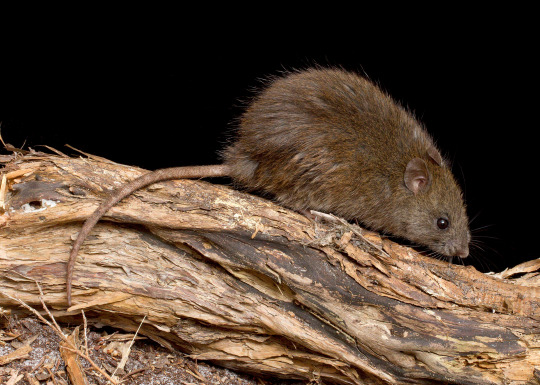
pictured: a cutie
The Project
The 250-hectare headland hasn’t always been a bush rat kingdom, though. Following a century of being vilified and exterminated from areas around Sydney Harbour, the bush rat population in North Head was wiped out decades ago by urbanization, habitat fragmentation, and predation by feral cats and foxes. The reserve was overrun by a gang of black rats, an invasive species that’s found on every continent except Antarctica. While bush rats help maintain the ecosystem’s native species, black rats wreak havoc. At North Head, they wasted no time plundering the burrows and tree hollow nests of small mammals and gorging on bird eggs, says Leo. “They were causing a lot of problems.”
But when given the chance, bush rats can be formidable ecological gatekeepers. In 2014, Leo and her team began reintroducing bush rats to North Head to drive out their intrusive counterparts. The rewilding effort is working, with annual wildlife surveys showing that black rat numbers dropped from an estimated 112 in 2019 to 29 by 2020. In May 2021, a mere nine black rats were captured. The project harnesses the bush rat’s innate territorial streak. The native rodents outcompete black rats for habitat and food, and Leo suspects that North Head will one day be a bush rat–only stomping ground. “If they’ve got the fort, they can maintain the territory,” she says.
For the reintroduction effort, Leo and her team captured 180 bush rats over three years from abundant populations in Muogamarra Nature Reserve and Ku-ring-gai Chase National Park, both located roughly 30 kilometers northwest of North Head. The researchers lured the rats into traps with a wholesome meal of oats, honey, and peanut butter, then assessed the animals’ genes to ensure they were diverse enough to build a flourishing new colony at North Head. After inserting a microchip into each rat, the team set the rodents free on the headland...
The Importance of Native Rodents
While most reintroductions focus on giving threatened species a boost, it’s just as important to prioritize common species in conservation efforts and rewilding projects, says Emily Roycroft, an evolutionary biologist specializing in native mammals and population genetics at the Australian National University. For instance, native rodents act as tiny engineers that shape the ecosystems they inhabit, spreading seeds, churning the soil, and keeping insect populations in check.
Native rodents provide fundamental ecosystem services, says Roycroft, who was not involved in Leo’s project. “We know that if [rodents] were once there, they were playing a role.”
Relocating common species like the bush rat can also provide a good dress rehearsal for riskier reintroductions, adds Roycroft. If something goes wrong when reintroducing a common species, there’s often enough time to tweak the approach and try again. But when researchers are dealing with a species that is on the brink of extinction, they only have one shot to get it right. “It might be the last chance for that particular species to establish a new population,” says Roycroft.
Leo suspects the bush rats have reclaimed their territory for good at North Head, which is now free of feral cats and foxes and protected from urban sprawl. “They’re pretty much established now,” she says. “I think they’ll continue to do well.”” -via Hakai Magazine, 1/11/23
#invasive species#native species#rodents#rats#wild rat#rewilding#reintroduction#endangered species#ecosystems#ecology#good news#hope#australia#ratblr
287 notes
·
View notes
Text
One big thing that gets missed in the conversation about native plants is that when considering a plant, you really should ask two questions:
1. Where, specifically, is it native to?
2. Within that region, what ecosystem conditions does it live in? Will it thrive where you intend to plant it?
I cannot tell you how many times I've come across a plant labeled as native that doesn't even grow in my state. Sure, it's native to the continent, but not this side of the rocky mountains! That's not nearly specific enough if your goal is to support endemic animal species and the overall ecosystem.
You also need to consider what conditions that plant needs to thrive. One example I see a lot of here is planting understory plants in full sun. They're stressed out, they're getting sunburnt, and they're slowly dying. People will also try the reverse, planting praire plants in deep shade, and wonder why they're all floppy and anemic looking. Plants may be native to your area, but they still have specific needs and you will have much greater success if you match the conditions you have to a plant that will thrive there.
A third, extra credit question is a two parter: is it endemic (aka, unique to your region) or does it have a a broader, or even circumpolar distribution? I mean, check out the range maps for Henderson's shooting star & twinflower:

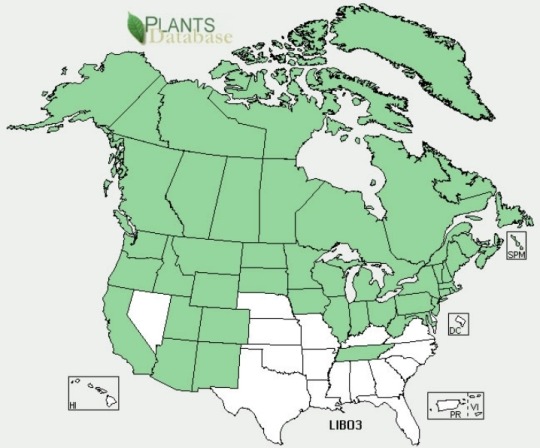
Twinflower is found across the northern portions of Eurasia as well.
The second part is, are any of the vulnerable species in your area depending on it? An example from my area is Viola Adunca, which has a pretty broad range,
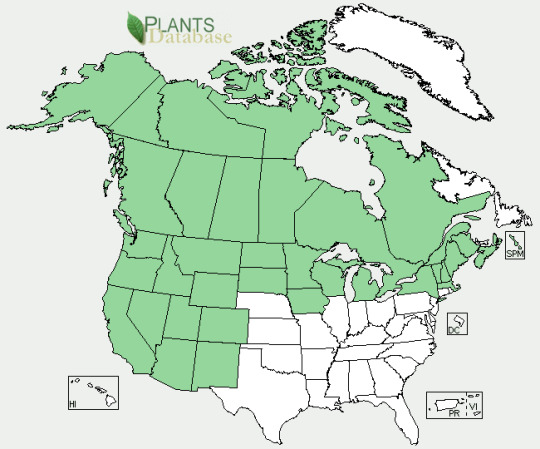
But is also host to multiple fritilary butterfly species in my area, some of which are on the decline and some of which are no longer found in my state. Due to habitat loss. Both due to human activity (agriculture, subdivisions, etc) and human inactivity (banning the intentional burns the Native peoples did, that maintained the Oak savanna ecosystem, leading them to be "invaded" by non-fire adapted Douglas firs, another native species. Also at the same time making the region more vulnerable to bigger and more devastating wild fires).
#gardening#native plants#native species#intentional fires were key to managing ecosystems throughout the west#and when our government killed#removed from the land#and then banned the remaining people from setting fires#we did so much harm to not only the ecosystems but also endangered ourselves#on top of the truly reprehensible behavior we showed to native peoples#I don't think people realize how much we changed the ecosystems here by banning fires#hunting beavers to near extinction#and killing off the bision and turning the land into range land for cattle & sheep
160 notes
·
View notes
Text
drew some mussels :) eventually i’ll be making these bad boys into a minnesota native mussel sticker set because i love mussels SO much and i want to share my love of them. i also realized recently that most people know that zebra mussels are bad, but i think we need to remember why zebra mussels are bad, not just that they are.
remember to always clean, drain, and dry your equipment to prevent the spread of zebra mussels and keep our native mussels safe :)

85 notes
·
View notes
Text
#good news#nature#science#environmentalism#environment#conservation#native plants#native species#forests#mini forests#regreening
49 notes
·
View notes
Text


Lampropeltis triangulum
#eastern milksnake#snakes#herps#native species#canada#my photos#ecology#wildlife#species at risk#spring 2023#nature photography
16 notes
·
View notes
Text
Virginia Bluebells (Mertensia virginica)
Blue flowers are relatively rare. Most incline to violet or else are quite small. But Virginia bluebells are a striking exception. All my photos from my garden, unedited.


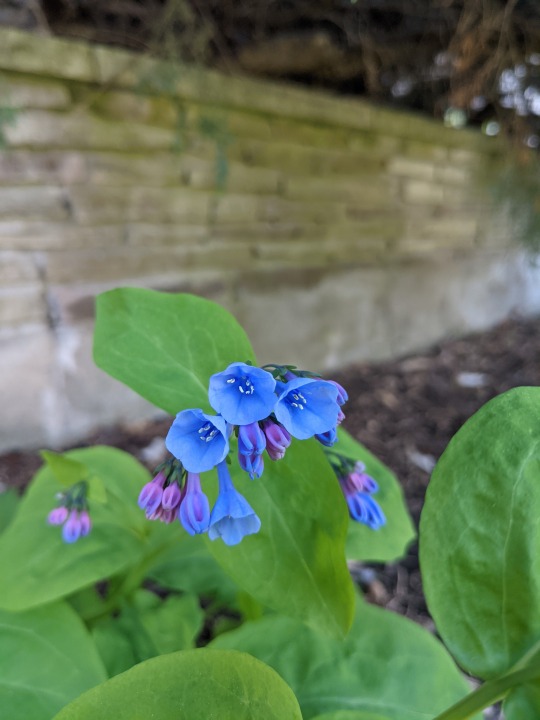



I'm not kidding. They really are that blue naturally. They bloom in May. Then they slowly decline and the entire plants are gone above soil by the summer. Only to reappear the following spring! The shoots and flower buds are edible. You don't want to take too much, though. As spring ephemerals, they need the energy they make with their leaves during their short growing period. The short bloom period is also why I don't have more photos of them. They don't even bloom every year.
#photography#my photos#blackswallowtailbutterfly#Virginia bluebells#Mertensia virginica#flowers#blue flowers#wildflowers#gardening#native species#North American native plants#edible wild plants#my garden#native plants of Ontario and the northeastern USA#spring ephemerals
15 notes
·
View notes
Text
So, long story short--a Master Gardener who has been maintaining a native plant garden for years is now being harassed by a neighbor, with whom the city code enforcers sided, and she's facing daily fines if she doesn't turn at least half of her yard into grass lawn. Apparently the only plants that are allowed to grow higher than seven inches are those that are edible, useful, or decorative.
If you are at all ecologically aware, you know that grass lawns are essentially ecological wastelands. A monoculture of non-native grass, especially if it's sprayed with herbicides, fertilizers, and so forth, is not going to support much in the way of native wildlife. Moreover, it can be argued that native plants do fall under the allowable category of "useful" and "decorative", and some are even "edible."
The article above is dated from two days ago, but this apparently started last year. And I found an article in their local paper from this past July that says she's still fighting the city about it, plus it has a bunch of photos of her garden if you want to see what the fuss is all about. Do be aware that if you decide to contact the Prospect Code Enforcement Board, City Council, and/or Mayor with a polite note in support of her, the website only allows you to send five messages every hour and you can only message one person at a time.
ETA: I did hear back just now from one of the code enforcement folks, who says--in their words--"Prospect City asked Ms. McGrail to redesign her current plantings into a more attractive and organized layout with edged definitions to her plant beds and a more obvious ‘walking path’ in between with a more “lawn-like” appearance, using native and no-mowing options"
#native plants#gardening#native species#plants#flowers#botany#nature#wildlife#habitat restoration#environment#conservation#ecology#lawns#no lawns#food not lawns
610 notes
·
View notes
Text
Oh boy what am I getting myself into
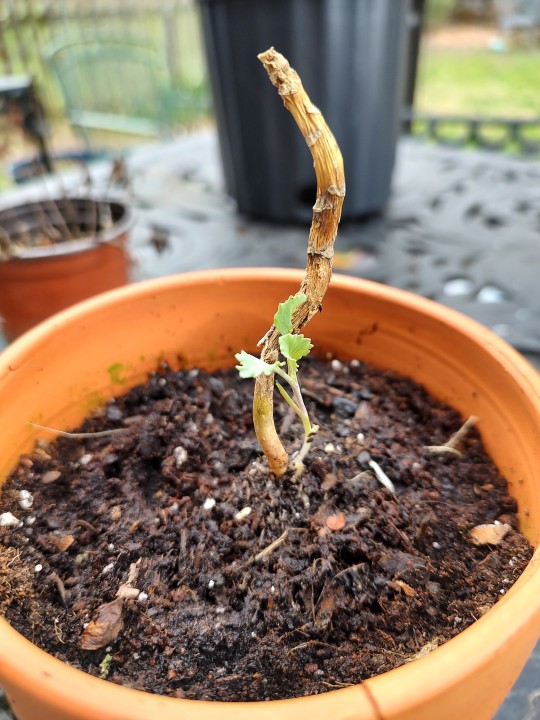
This is Yellow Jessamine- a perennial vine native to my area, it's great for pollinators- producing yellow flowers that bees, hummingbirds, and butterflies just love
But man I strongly dislike it.
As a child I planted some in my garden- it died
Or so I thought
This bad boy came back and completely obliterated my garden, it spread wildly and took over everything in its path, by the time my childhood interest in gardening rekindled I was left with this to clean up.
It took weeks of breaking my back to finally get it all up
Except I didn't. You can't get it all out- the roots of mine we're everywhere and while I pulled up most of them there were a few stragglers what were too hard to get rid of
And now the boy is back and instead of waging war I'm offering the olive branch
Everywhere he comes up I'm just going to post him up
And when he gets big enough I'm sending him to the edge of the property that my good ol creek is on, where he will begin to wage a far greater war than either of us could imagine- the fight against the lawn, along the fence that separates the forest from the neighbors I will plant him and he will grow, blooming, attracting bees, supporting the ecosystem
If you're going to grow yellow jessamine make sure it's a native species for one, and two make sure that you plant it where your okay with it spreading, it can grow 5 feet a year when it's established
I look forward to the day when I get to trespass and leave this baby behind, I think he'll do good out there.
#yellow jessamine#vines#perennial plants#guerilla gardening#gardening#gardenblr#nature#native species#pollinators
66 notes
·
View notes
Text
#Lawns
11 notes
·
View notes